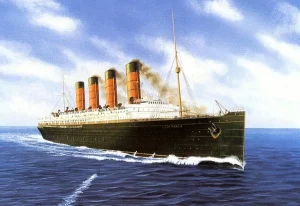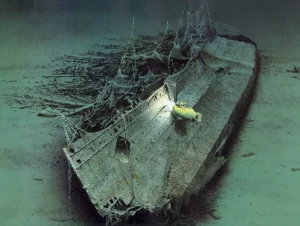The RMS Lusitania is one of the most famous ships in maritime history, remembered for its impressive engineering, luxurious design, and its tragic sinking during World War I. Built on the River Clyde in Scotland, Lusitania was a marvel of early 20th-century shipbuilding, symbolizing British naval supremacy.
Origins and Purpose (Late 19th Century – Early 20th Century)
By the late 19th century, transatlantic ocean liners had become a crucial part of global travel and commerce, with British, German, and American companies competing fiercely for dominance in this industry. The Cunard Line, a prestigious British company, sought to maintain its leadership by building a new class of superliners to rival German ships like the Deutschland.
The Lusitania and its sister ship Mauretania were conceived in the early 1900s as part of Cunard’s strategy to retain its prominence and provide faster and more luxurious travel between Europe and the United States. These ships were also designed to be convertible into auxiliary cruisers for the British Navy, in line with government incentives.
In 1903, the British government loaned Cunard £2.6 million (about £300 million in today’s value) to build these ships under the condition that they be built in British yards, ensuring employment and technological investment at home. The Clyde, with its rich shipbuilding tradition, was the natural choice for such an ambitious project.

Construction on the Clyde (1904 – 1906)
The Lusitania was built at the John Brown & Company shipyard in Clydebank, located along the River Clyde, one of the most prominent shipbuilding regions in the world. Construction began on June 16, 1904, with the laying of her keel. John Brown’s shipyard had a reputation for building innovative and large ships, and Lusitania was a massive undertaking. At 790 feet long and weighing 31,550 tons, she was one of the largest ships ever built at the time.
Key features of her design included:
Four steam turbines, which gave the ship an unprecedented speed of over 25 knots, making her one of the fastest transatlantic vessels.
Quadruple funnels, which were a signature feature, designed to emphasize power and speed.
Luxurious interiors, with grand dining rooms, smoking lounges, and first-class cabins outfitted to compete with the best accommodations on the seas.
Her hull was constructed using a method known as “sheer strake,” which provided extra strength and buoyancy, allowing her to withstand heavy seas. The ship was launched on June 7, 1906, amid great fanfare, in front of thousands of spectators. Fitting out (adding interior features, engines, and equipment) took several more months before Lusitania was ready for her maiden voyage.
Maiden Voyage and Service (1907 – 1915)
The Lusitania embarked on her maiden voyage on September 7, 1907, from Liverpool to New York City. The ship quickly gained a reputation for speed and luxury, setting records for the fastest Atlantic crossing. She earned the coveted Blue Riband for the fastest transatlantic crossing, completing the journey in just under five days.
For the next eight years, Lusitania served as one of the premier ocean liners, transporting thousands of passengers across the Atlantic. Her speed and reliability made her a favourite among wealthy travellers, but she was also designed to carry immigrants in third-class cabins, many of whom were seeking better lives in the United States. The Lusitania was part of a broader trend of transatlantic migration, which was peaking during this period.

Notable features of the ship’s operation included:
Speed and regularity, with the ship maintaining a regular schedule between Liverpool and New York, often completing voyages in record time.
Class distinction, with first-class passengers enjoying unparalleled luxury, while third-class accommodations were relatively Spartan but still considered better than many other ships.
Despite her peaceful purpose, Lusitania was also equipped for wartime use. The ship had provisions for installing naval guns and was registered as an auxiliary cruiser, though she was never armed.
The Sinking of the Lusitania (May 7, 1915)
By 1914, World War I had engulfed Europe, and naval warfare was a critical part of the conflict. German U-boats (submarines) posed a significant threat to British shipping, including passenger liners. Despite the danger, the Lusitania continued her regular transatlantic service.
On May 1, 1915, the Lusitania departed New York for Liverpool, carrying nearly 2,000 passengers and crew. Among them were men, women, children, and notable figures from the worlds of business and politics. The ship’s captain, William Turner, was aware of the German U-boat threat but relied on the ship’s speed to outrun any danger.
However, on May 7, 1915, off the southern coast of Ireland, German submarine U-20 fired a torpedo at the Lusitania. The torpedo struck the ship on the starboard side, causing a massive explosion. A second explosion followed, which many historians believe was caused by munitions secretly carried in the ship’s hold. Within 18 minutes, the Lusitania sank, taking 1,198 lives, including 128 Americans.
The sinking of the Lusitania shocked the world and had profound consequences:
Political impact: The event stirred anti-German sentiment in the United States and is often cited as a key factor leading to American involvement in World War I.
Controversy over munitions: The presence of munitions on board has been debated, with some arguing that the ship was a legitimate military target, while others condemned the attack as an atrocity.
Legacy and Aftermath
The sinking of the Lusitania was a pivotal moment in World War I and remains one of the most famous maritime disasters in history. The tragedy became a powerful symbol of German aggression and was used in Allied propaganda to rally support for the war effort.
The Clyde shipbuilding industry, which produced the Lusitania, continued to play a crucial role in the war, producing ships for the British navy and merchant marine. However, the loss of the Lusitania was a blow to British morale and an early example of the devastating power of modern warfare.
Today, the wreck of the Lusitania lies off the coast of Ireland, a reminder of both the glory and the tragedy of early 20th-century ocean liners. Her story is preserved in museums and memorials, and her legacy as one of the most luxurious and tragic ships ever built endures.


